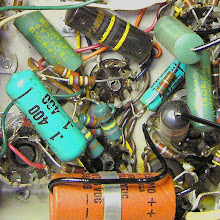Here's hows how a discharge probe is used to bleed voltage off of a capacitor. This cap is completely removed from the circuit for illustrational purposes, but the procedure is the same when a cap is installed in an amplifier. The meter is tough to read here but I hope it's good enough to get the general idea.
The resistor at the clip end of the probe is a 56K 3 Watt one covered in two layers of shrink tubing for safety. The resistor will limit the current from a 450 Volt supply to under 10 ma but it is still a very good idea not touch the alligator clip end of the probe while connecting the other end to the B+. I'll cover the probe construction in a later post.
THE UBIQUITOUS DISCLAIMER: AKAVALVE ASSUMES NO RESPONSIBILITY FOR THE SAFETY OF ANYONE IMPLEMENTING THESE INSTRUCTIONS. IF YOU ARE NOT FAMILIAR WITH SAFE PRACTICE IN HIGH VOLTAGE CIRCUITS, DO NOT ATTEMPT THIS YOURSELF.
The resistor at the clip end of the probe is a 56K 3 Watt one covered in two layers of shrink tubing for safety. The resistor will limit the current from a 450 Volt supply to under 10 ma but it is still a very good idea not touch the alligator clip end of the probe while connecting the other end to the B+. I'll cover the probe construction in a later post.
THE UBIQUITOUS DISCLAIMER: AKAVALVE ASSUMES NO RESPONSIBILITY FOR THE SAFETY OF ANYONE IMPLEMENTING THESE INSTRUCTIONS. IF YOU ARE NOT FAMILIAR WITH SAFE PRACTICE IN HIGH VOLTAGE CIRCUITS, DO NOT ATTEMPT THIS YOURSELF.




2 comments:
I'm enjoying, learning... thank you so much!
Won't you add the "one hand in your pocket" traditional golden rule here?
Excellent, thanks - looking everywhere for a clear explanation of how to discharge caps safely, using correct tools, methods and common sense.
I'm going to build a small tube amp (Champ/Princeton or Deluxe) so reading lots first - will look around your blog for more good info!
Cheers!
Rich
Post a Comment